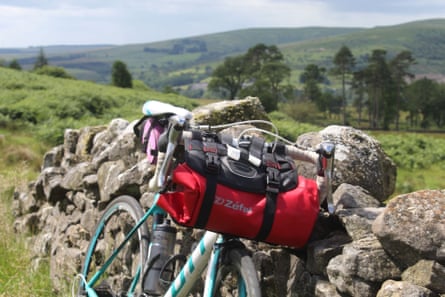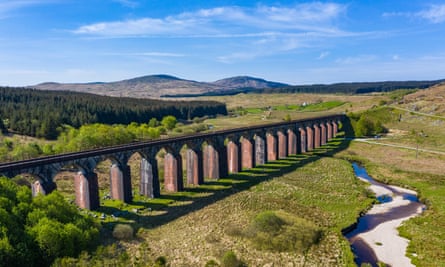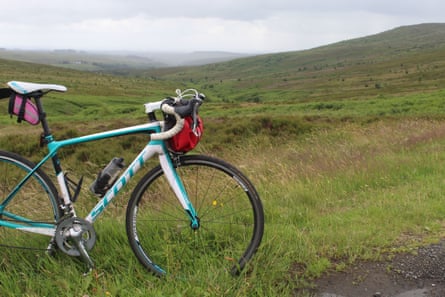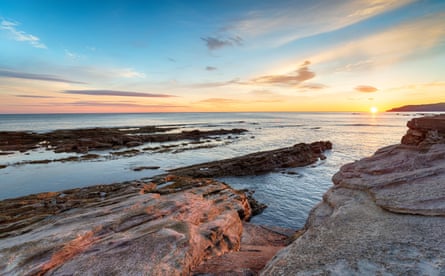The weather-beaten curves of a battered stone wall guide me out of Langholm, an idyllic old textile town tucked between the hills of the Esk valley, eight miles north of the English border.
As I pedal slowly around a steep corner, a lamb and her mother, grazing on the grassy fringes, scurry off up the road. I appreciate their show of faith in my cycling abilities, but on gradients of 9%, I wouldn’t have been able to keep their pace even if they’d crawled off. I pause for a breather at the MacDiarmid Memorial, a huge, metal sculpture of an open book, embellished with images from the work of the great poet Hugh MacDiarmid, who was born in Langholm.
The artwork depicts thistles, trout, eagles and ploughs, while the green of the forests and farmland behind shine through the silhouettes etched out of the framework. “Scotland small? Our multiform, our infinite Scotland small?” MacDiarmid famously wrote.
It certainly doesn’t feel small when you’re cycling across it.

I’ve been on my bike for a few days at this point, riding the Kirkpatrick C2C; south Scotland’s new coast-to-coast route, which runs 250 miles from Stranraer in Dumfries and Galloway on the west coast to Eyemouth in the Borders on the east. The waymarking will come next year, but the route is online now for experienced cyclists inspired to ride by the world’s first ever combined UCI World Championship events, which started last week, and are currently being contested around Scotland.
“The bike is part of our identity and culture here,” says Paula Ward, of South of Scotland Enterprise, one of various tourism bodies involved in the creation of the Kirkpatrick C2C. “The area is well known for cycling already, but this gives people a pre-logged route that you can download,” says Ward. “That makes it easy to come here to the south of Scotland to explore, having watched something like the World Championships or the Tour of Britain.”
The route is named after Kirkpatrick Macmillan, the Dumfriesshire blacksmith widely credited as having invented the first pedal-driven bicycle in the 1830s. “It’s one of our universal truths,” says Ward. “The south of Scotland gave the world the bike.”

Dumfries and Galloway is sometimes called Scotland’s forgotten corner, and after the decline of the textile industry in the 80s, Langholm risked becoming Scotland’s forgotten town. The Langholm Initiative was set up in 1994 to change that, and in 2019, they led a community buyout of the local moorland. Today, the community owns 4,200 hectares (10,500 acres) of this sublime countryside – and has transformed an old grouse moor into the Tarras Valley nature reserve.
The Kirkpatrick C2C cuts through the heart of the reserve, on a single-track road looking out to Solway Firth. The moorland is dotted with naturally regenerating birch, rowan and alder trees, spreading up the valley from the ancient forest, along the River Tarras. I stop to watch wild goats butt horns at the side of the road, and spot a hen harrier gliding in the distance.
I had rolled out of Stranraer a few days earlier, after breakfast at the Fig & Olive cafe, where the toilets are plastered with posters of classic climbs and a cycling jersey is framed on the wall.

There are two suggested itineraries for the route – a four-day “Challenger” ride or an eight-day “Explorer” option, both covering the same 250 miles. I opt for a version of the latter, riding an average of 30 miles a day, with overnight stays in Wigtown, Castle Douglas, Dumfries (the largest town on the route), Langholm, Hawick, Melrose and Coldstream before reaching Eyemouth. The route combines sleepy B and C-roads and national cycle routes to guide you safely across the country.
My first day stretched 32 miles past ocean, forest and farmland to Wigtown, Scotland’s charming National Book Town. There, I explored the nooks and crannies of The Bookshop, Scotland’s largest secondhand bookshop. I socialised at The Open Book, a not-for-profit which lets tourists run a bookshop for a week, and met The Bookshop Band – folk musicians Ben Please and Beth Porter – who write songs inspired by books and perform them in bookshops. “It’s the community here that makes it special,” Please says. And, presumably, the 15 bookshops.
After a night in the Booktown Bunkhouse, I descend from misty vistas of the salt marsh and mudflats of Wigtown Bay through farmland, to the River Cree and Newton Stewart. The route turns away from the coast, into the Galloway Hills, and I detour past Creetown to see the Big Water of Fleet Viaduct, part of an old railway line featured in John Buchan’s The 39 Steps.

I soon reach the pastel houses of Kirkcudbright, a harbour town with MacLellan’s Castle at its centre and a vibrant arts scene. It’s here that trail-setter Pete Corson, who provided the spine of the Kirkpatrick C2C route, runs cycling tour operator Trailbrakes. “You come past Barlocco Island, and it’s unspoiled and rolling,” he says, of the section of trail on his doorstep. “You follow gorse bushes, and come to a view down Kirkcudbright Bay, out to the isle of Little Ross.”
I ride on, via winding climbs and pastoral panoramas, to Castle Douglas, a town known for its food and its cycling. The two collided back in 2016. “Mark Cavendish crashed into the Chinese on the corner on the Tour of Britain,” David Fulton, owner of the King’s Arms Hotel, tells me. Cav would return in 2022 – this time sprinting safely past the Jade Palace to win the British National Road Championships. There’s a reason these events keep coming back here.
after newsletter promotion
“It’s a cycling town,” Fulton says. “We’ve got hills, coast and this huge network of quiet roads.” I’m served a calorie-rich full Scottish breakfast at the hotel (marginal gains) before being sent on my way.
In Dumfries, I grab a coffee at the Frothy Bike Co – a magnet for cyclists hunting hard-earned caffeine, and via Lockerbie and a lush road by the River Esk, I roll into Langholm, 150 miles in. After the Tarras valley, the route passes from Dumfries and Galloway into the Scottish Borders.

I descend to Newcastleton, unfortunately one day late for the Copshaw Common Riding – an annual festival where they mark the town boundaries. In most Borders towns, this riding occurs on horses. Here, they use bikes – though not before some peculiar pageantry. The “snogging of the sod and supping of the tequila” particularly stands out on the eccentric order of ceremony.
Six miles on, I come to Hermitage Castle, a fierce 14th-century fortress. I’m the only visitor and am left to explore the ancient staircases alone. Mary Queen of Scots once rode 25 miles on horseback to visit her future husband, the Earl of Bothwell, here, and Sir Walter Scott adored the castle. The remainder of the route passes through an abundance of Scott history – from Selkirk, where the Waverley author sat as sheriff, to Abbotsford, his lavish Tweedbank palace.
I cycle past the 12th-century Borders abbeys of Melrose, Dryburgh and Kelso, before a buzzard leads me into Coldstream, where I spend my final night at Bank House, overlooking a bend in the Tweed that marks the border. Golden hour has hit the river when I wake. Siskins flutter around damp roadside hedges, and hares dash through fields as I ride the final 25 miles to Eyemouth.

When gulls begin to circle, I know I’m near. One final climb, then I roll down to the east coast waves, which lap gently on to Eyemouth beach, backdropped by red sandstone cliffs.
As a Scot, there’s something special in riding this coast-to-coast, putting home into context and bringing the map of the country to life. The Kirkpatrick C2C is a cycling colossus; an education in Borderland beauty and community, with a deep literary, historical vein throughout.
“Scotland small?” The words of MacDiarmid pop back into my head as I watch a tourist toss a fish down to a chunky harbour seal. It doesn’t feel small when you’ve cycled across it.
The Kirkpatrick C2C runs 250 miles from Stranraer to Eyemouth. Get more details from Scotland Starts Here
